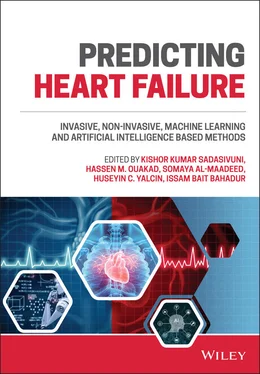Predicting Heart Failure
Здесь есть возможность читать онлайн «Predicting Heart Failure» — ознакомительный отрывок электронной книги совершенно бесплатно, а после прочтения отрывка купить полную версию. В некоторых случаях можно слушать аудио, скачать через торрент в формате fb2 и присутствует краткое содержание. Жанр: unrecognised, на английском языке. Описание произведения, (предисловие) а так же отзывы посетителей доступны на портале библиотеки ЛибКат.
- Название:Predicting Heart Failure
- Автор:
- Жанр:
- Год:неизвестен
- ISBN:нет данных
- Рейтинг книги:3 / 5. Голосов: 1
-
Избранное:Добавить в избранное
- Отзывы:
-
Ваша оценка:
- 60
- 1
- 2
- 3
- 4
- 5
Predicting Heart Failure: краткое содержание, описание и аннотация
Предлагаем к чтению аннотацию, описание, краткое содержание или предисловие (зависит от того, что написал сам автор книги «Predicting Heart Failure»). Если вы не нашли необходимую информацию о книге — напишите в комментариях, мы постараемся отыскать её.
Predicting Heart Failure: Invasive, Non-Invasive, Machine Learning and Artificial Intelligence Based Methods
Predicting Heart Failure
Predicting Heart Failure: Invasive, Non-Invasive, Machine Learning and Artificial Intelligence Based Methods
Predicting Heart Failure — читать онлайн ознакомительный отрывок
Ниже представлен текст книги, разбитый по страницам. Система сохранения места последней прочитанной страницы, позволяет с удобством читать онлайн бесплатно книгу «Predicting Heart Failure», без необходимости каждый раз заново искать на чём Вы остановились. Поставьте закладку, и сможете в любой момент перейти на страницу, на которой закончили чтение.
Интервал:
Закладка:
2.3.5 Claudication
Claudication is a pain, cramp, or sense of fatigue that results from the lower blood flow to the muscles during exercise. This affects the muscle group of the lower extremities and causes pain in the legs depending on the pace and duration of the walk. It is relieved promptly within a few minutes of rest in positions such as standing evenly on both feet. This condition can occur anywhere in the body, but is predominantly in the legs. Even though the pain is not constant and subsides with rest, it can be a symptom of peripheral artery disease.
2.3.6 Recording History of Heart Disease
In many heart patients, mostly adults, the heart disease or discomfort related to the heart won’t begin suddenly in a day. A detailed study about the history of any chest discomfort or heart disease experienced by the patient in the past can provide additional information about the underlying disease for the cardiologist. The history recording procedure investigates whether the patient has suffered any heart attack or coronary artery diseases, whether they have undergone any heart surgery in the past, their medication history, etc. The cardiologist will also ask when an incident happened, how it was diagnosed, about the patient’s lifestyle after that incident, etc. Furthermore, the history recording procedure will inquire into whether the patient was healthy during their childhood, whether they were very active and took part in soft or vigorous sports activities, etc.
2.3.7 Family History
The cardiologist enquires about the family history of the patient including whether any cases of heart attacks, strokes, coronary artery diseases, acute heart diseases, and early death linked to heart disease have occurred in the patient’s family. The family history of heart disease recording is based on the fact that, if family members have suffered from any heart or cardiovascular disease, then the patient is more likely to have the heart disease. The brothers or sisters of a patient with heart disease are 40% more likely to suffer heart disease in the future, while the offspring of patients with early heart disease are 60 –75% more prone to heart diseases [7].
2.3.8 Blood Pressure and Pulse
The amount of force used by the heart to pump blood across the body is referred to as blood pressure; in other words, the pressure generated when the heart pumps blood into the circulatory system. Blood pressure is measured using a sphygmomanometer or blood pressure monitor in millimeters of mercury unit (mmHg). There will be two components for each reading of blood pressure, the systolic and diastolic pressures. The force exerted on the walls of arteries by the heart during systole is called systolic pressure. The systole is a short span where the ventricles of the heart are contracted, and it happens in between the first and second heart sound. Diastolic pressure is the force exerted on the walls of arteries between the beats. Generally, blood pressure levels between 120 and 80 mmHg are considered normal. Blood pressure level measurement has significant importance in the heart disease examination procedure. Several studies have found that high blood pressure levels have a clear link with the risk of strokes as well heart diseases in individuals irrespective of their ages [8]. However, a study [9] conducted in different age groups of the Framingham heart study participants observed that in individuals aged less than 50 the diastolic blood pressure levels are a clear indicator for predicting heart disease. On the other hand, systolic pressure levels along with pulse pressure levels are the clear predictor of heart diseases in individuals over 50 years old.
The heart rate, or the cumulative number of times the heart beats in a minute, is referred to as pulse. If the person is resting, 60–100 beats per minute are considered natural. The heart rate can elevate up to 150 if the person is involved in any highly vigorous activity. If the resting heart rate of an individual is less than 60, then it is called bradycardia and, if it is greater than 100/120, then it is called tachycardia. Bradycardia is often linked with underlying heart diseases such as heart failure. Similarly, tachycardia can be an early symptom of heart failure or stroke.
2.3.9 Total Cholesterol, Triglycerides, and Associated Lipid Profiles
The lipid fraction of the human body is made up of cholesterol, triglycerides, and high-density lipoproteins (HDLs). Elevated cholesterol levels in the human body can increase the chances of developing heart diseases and stroke. The cholesterol level of a human body is measured by drawing blood samples. The cholesterol level examination generates the measurement of four types of fats (lipids) in the blood: total cholesterol; HDL cholesterol; low-density lipoprotein (LDL) cholesterol; and triglycerides. The overall amount of cholesterol in the blood is known as total cholesterol. HDL cholesterol is known as the “good” cholesterol as it aids in the removal of LDL cholesterol, allowing arteries to remain open and blood to circulate freely. A higher amount of HDL in the blood lowers the rate of heart disease risk [10]. LDL cholesterol is known as “bad” cholesterol since a higher amount of LDL in blood induces atherosclerosis, which is the accumulation of fatty deposits (plaques) in arteries. These plaques may hinder blood flow and cause a heart attack or stroke. Therefore, a higher LDL level represents a higher risk of heart disease [11]. Triglycerides are a type of fat that occurs naturally in the body. Extra calories consumed over the total energy expenditure of a body get converted into triglycerides. These triglycerides are contained in fat cells and are later released into the blood when the body requires energy to do any activity. The elevated level of triglycerides in the blood is due to many reasons, such as obesity, thyroid or liver disease, and genetic conditions. High triglyceride levels are linked to the increased risk of heart disease [12]. A bad diet that includes a significant amount of butter, oil, and excess sugar can cause an increase in the level of triglycerides in the body. Eating a lot of foods rich in carbohydrates or sugar and drinking excessive amounts of alcohol lead to high triglycerides levels in the human body. Apart from food, the main cause of increased triglyceride levels is a sedentary lifestyle. Certain types of food should be avoided or limited if the patient has high triglyceride levels: the intake of starchy vegetables like corn and peas should be limited, while canned fish or beef packed in oil should be avoided. Baked foods that contain a high level of saturated fat should also be avoided and the consumption of butter or margarine should be limited or replaced with olive oil. Lean meats should be preferred over high fat meats such as beef or pork. Moreover, all processed meats are bad for patients with higher levels of triglycerides and should be avoided.
2.3.10 Bruits and Hums of the Head and Neck
A bruit refers to the vascular sound associated with turbulent blood flow. This will be audible and detected with a stethoscope. These auscultatory sounds originating in the heart and radiating to the neck are considered to be cardiac valvular murmurs. A carotid bruit is the sound heard over the cervical arteries and can indicate the underlying arterial occlusive pathology which can lead to a stroke. The carotid artery bruit can also be caused by atherosclerotic stenosis in adults. The cervical venous hum is often felt over the internal jugular cervical veins and is due to the combined effects of gravity on the blood flow and the partial compression of the vein by the transverse process of the atlas. These sounds, especially venous hum, are more common in children than adults and are quite normal. Cranial and orbital bruits, vibrations resulting from turbulence in intracranial or extracranial vessels, are less serious and normally occurring in the younger population. However, cranial-orbital bruits present in the adult category, are usually pathologic and indicate an underlying abnormality such as arteriovenous fistulas, arteriovenous malformations, and intracranial hemangiomas. In addition, an orbital bruit can occur rarely as a result of the atherosclerosis of the arteries in the neck.
Читать дальшеИнтервал:
Закладка:
Похожие книги на «Predicting Heart Failure»
Представляем Вашему вниманию похожие книги на «Predicting Heart Failure» списком для выбора. Мы отобрали схожую по названию и смыслу литературу в надежде предоставить читателям больше вариантов отыскать новые, интересные, ещё непрочитанные произведения.
Обсуждение, отзывы о книге «Predicting Heart Failure» и просто собственные мнения читателей. Оставьте ваши комментарии, напишите, что Вы думаете о произведении, его смысле или главных героях. Укажите что конкретно понравилось, а что нет, и почему Вы так считаете.












